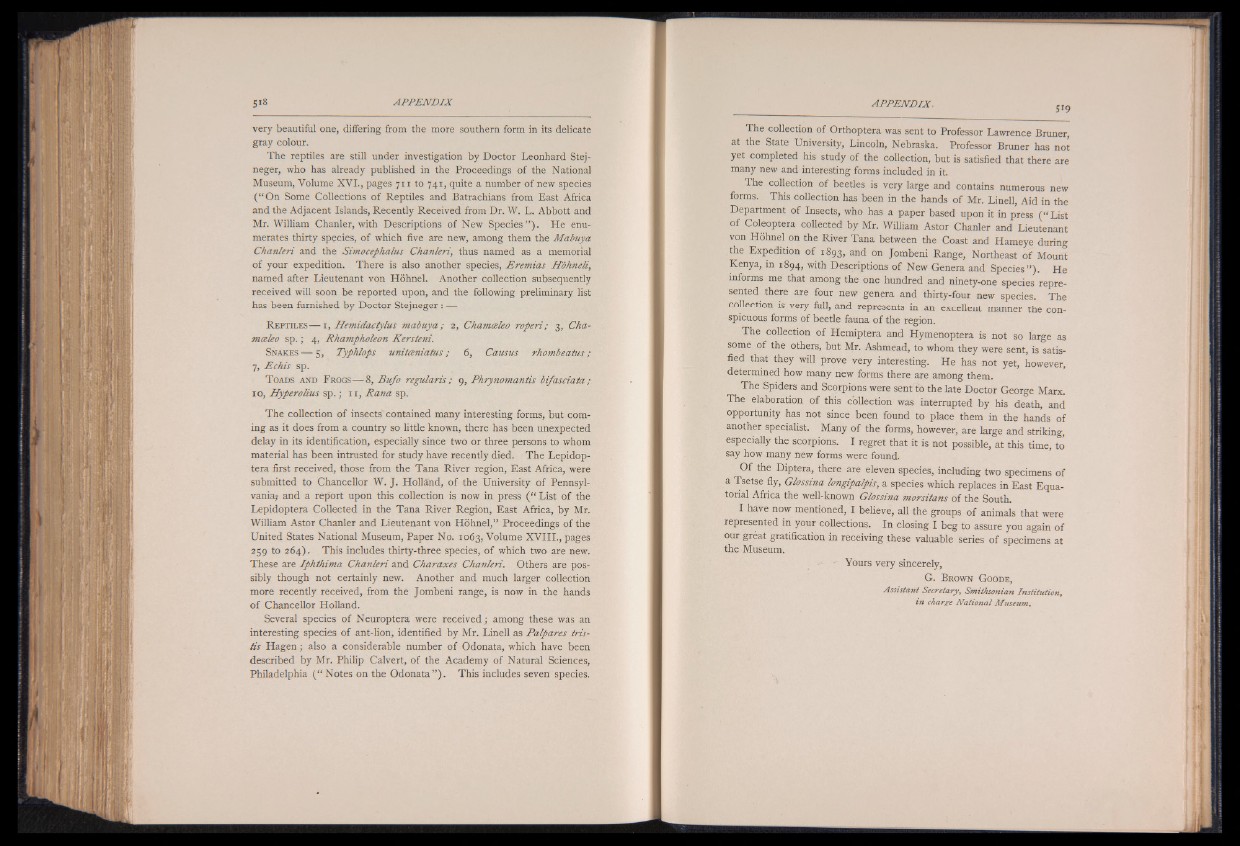
very beautiful one, differing from the more southern form in its delicate
gray colour.
The reptiles are still under investigation by Doctor Leonhard Stej-
neger, who has already published in the Proceedings of the National
Museum, Volume XVI., pages 711 to 741, quite a number of new species
(“ On Some Collections of Reptiles and Batrachians from East Africa
and the Adjacent Islands, Recently Received from Dr. W. L. Abbott and
Mr. William Chanler, with Descriptions of New Species” ). He enumerates
thirty species, of which five are new, among them the Mabuya
Chanleri and the Simocephalus Chanleri, thus named as a memorial
of your expedition. There is also another species, Eremias Hohneli,
named after Lieutenant von Hohnel. Another collection subsequently
received will soon be reported upon, and the following preliminary list
has been furnished by Doctor Stejneger: —
R e p t il e s— 1, Hemidactylus mabuya; 2, Chamceleo roperi; 3, Chamceleo
sp.; 4, Rhampholeon Kersteni.
Sn a k e s — 5, Typhlops unitcenialus; 6, Causus rhombeatus ;
7, Echis sp.
T o ad s a n d F r o g s— 8, Bufo regularis; 9, Phrynomantis bifasciata;
xo, Hyperolius sp.; 11, Rana sp.
The collection of insects contained many interesting forms, but coming
as it does from a country so little known, there has been unexpected
delay in its identification, especially since two or three persons to whom
material has been intrusted for study have recently died. The Lepidop-
tera first received, those from the Tana River region, East Africa, were
submitted to Chancellor W. J. Holland, of the University of Pennsyl-
vaniaj and a report upon this collection is now in press (“ List of the
Lepidoptera Collected in the Tana River Region, East Africa, by Mr.
William Astor Chanler and Lieutenant von Hohnel,” Proceedings of the
United States National Museum, Paper No. 1063, Volume XVIII., pages
259 to 264). This includes thirty-three species, of which two are new.
These are Iphthima Chanleri and Charaxes Chanleri. Others are possibly
though not certainly new. Another and much larger collection
more recently received, from the Jombeni range, is now in the hands
of Chancellor Holland.
Several species of Neuroptera were received; among these was an
interesting species of ant-lion, identified by Mr. Linell as Palpares tris-
lis Hagen; also a considerable number of Odonata, which have been
described by Mr. Philip Calvert, of the Academy of Natural Sciences,
Philadelphia (“ Notes on the Odonata” ). This includes seven species.
The collection of Orthoptera was sent to Professor Lawrence Bruner,
at the State University, Lincoln, Nebraska. Professor Bruner has not
yet completed his study of the collection, but is satisfied that there are
many new and interesting forms included in it.
The collection of beetles is very large and contains numerous new
forms. This collection has been in the hands of Mr. Linell, Aid in the
Department of Insects, who has a paper based upon it in press (“ List
of Coleóptera collected by Mr. William Astor Chanler and Lieutenant
von Höhnel on the River Tana between the Coast and Hameye during
the Expedition of 1893, and on Jombeni Range, Northeast of Mount
Kenya, in 1894, with Descriptions of New Genera and Species” ). He
informs me that among the one hundred and ninety-one species represented
there are four new genera and thirty-four new species. The
collection is very full, and represents in an excellent manner the con-
spicuous forms of beetle fauna of the region.
The collection of Hemiptera and Hymenoptera is not so large as
some of the others, but Mr. Ashmead, to whom they were sent, is satisfied
that they will prove very interesting. He has not yet, however,
determined how many new forms there are among them.
The Spiders and Scorpions were sent to the late Doctor George Marx.
The elaboration of this collection was interrupted by his death, and
opportunity has not since been found to place them in the hands of
another specialist. Many of the forms, however, are large and striking,
especially the scorpions. I regret that it is not possible, at this time, to
say how many new forms were found.
Of the Díptera, there are eleven species, including two specimens of
a Tsetse fly, Glossina longipalpis, a species which replaces in East Equatorial
Africa the well-known Glossina morsitans of the South.
I have now mentioned, I believe, all the groups of animals that were
represented in your collections. In closing I beg to assure you again of
our gréat gratification in receiving these valuable series of specimens at
the Museum.
Yours very sincerely,
G . B r ow n G oo d e ,
A ssistant Secretary, Smithsonian In stitu tion ,
in charge N a tion a l Museum.